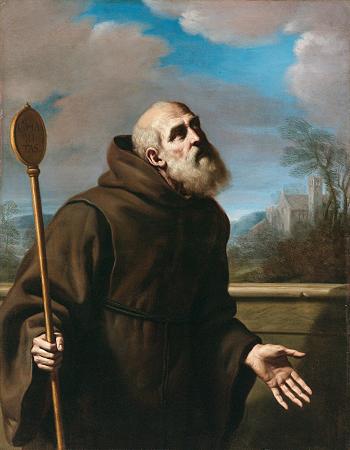Saint Francis of Paola. Saint Francis of Paola, O.M. was an Italian mendicant friar and the founder of the Roman Catholic Order of Minims. Unlike the majority of founders of men's religious orders, and like his patron saint, Francis was never ordained a priest. Francis was born in the town of Paola, which lies in the southern Italian Province of Cosenza, Calabria. In his youth he was educated by the Franciscan friars in Paola. His parents, having remained childless for some years after their marriage, had recourse to prayer and especially commended themselves to the intercession of St. Francis of Assisi, after whom they named their first-born son. Two other children were eventually born to them. When still in the cradle, Francis suffered from a swelling which endangered the sight of one of his eyes. His parents again had recourse to Francis of Assisi and made a vow that their son should pass an entire year wearing the little habit of St Francis in one of the friaries of his Order, a not-uncommon practice in the Middle Ages. The child subsequently recovered. At the age of 13, being admonished by a vision of a Franciscan friar, he entered a friary of the Franciscan Order to fulfill the vow made by his parents. At the completion of the year he went with his parents on a pilgrimage to Assisi, Rome, and other places of devotion. Returning to Paola, he selected a secluded cave on his father's estate and there lived in solitude; but later on he found an even-more secluded cave on the sea coast. Here he remained alone for about six years, giving himself to prayer and mortification. In 1435 two companions joined him in his retreat, and to accommodate them Francis caused three cells and a chapel to be built: in this way the new order was begun. By 1436, he and two followers began a movement that would become the foundation of the Hermits of Saint Francis of Assisi, which would later be renamed as the Minim friars. Their name refers to their role as theleast of all the faithful. Humility was to be the hallmark of the brothers as it had been in Francis's personal life. Abstinence from meat and other animal products became a fourth vow of his religious order, along with the traditional vows of poverty, chastity and obedience. Francis instituted the continual, year-round observance of this diet in an effort to revive the tradition of fasting during Lent, which many Roman Catholics had ceased to practice by the 15th century. The rule of life adopted by Francis and his religious was one of extraordinary severity. He felt that heroic mortification was necessary as a means for spiritual growth. They were to seek to live unknown and hidden from the world. The number of his disciples gradually increased, and about 1454, with the permission of Pyrrhus, Archbishop of Cosenza, Francis built a large monastery and church. The building of this monastery was the occasion of a great outburst of enthusiasm and devotion on the part of the people towards Francis: even the nobles carried stones and joined in the work. Their devotion was increased by the many miracles which the saint wrought in answer to their prayers. In 1474 Pope Sixtus IV gave him permission to write a rule for his community, and to assume the title of Hermits of St. Francis: this rule was formally approved by Pope Alexander VI, who, however, changed their title into that of Minims. After the approbation of the order, Francis founded several new monasteries in Calabria and Sicily. He also established monasteries of nuns, and a third order for people living in the world, after the example of St. Francis of Assisi. He was no respecter of persons based solely on their worldly rank or position. He rebuked the King of Naples for his ill-doing and in consequence suffered persecution. When King Louis XI of France was in his last illness, he sent an embassy to Calabria to beg the saint to visit him. Francis refused to come until the pope ordered him to go. Embarking at Ostia, he landed in France, and cured many sick of the plague in Provence as he passed. He then went to the king at his residence, the Chateau de Plessis-lez-Tours, and was with him at his death. He became a tutor of the heir, Charles VIII, who kept him near the court and frequently consulted him. This king built a monastery for the Minims there near the chateau at Plessis and another at Rome on the Pincian Hill. Francis also influenced many in the French church, particularly Jan Standonck, who founded the College de Montaigu along what he thought were Minimist lines. The regard in which Charles VIII held the saint was shared by Louis XII, who succeeded to the French throne in 1498.
more...



